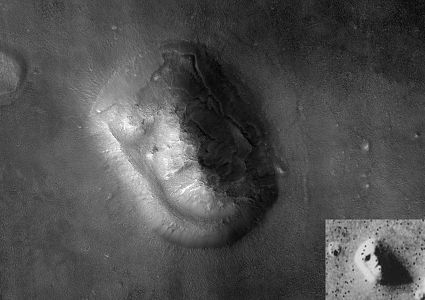Mars Reconnaissance Orbiter image by its HiRISE camera of the "Face on Mars".
Viking Orbiter image inset in bottom right corner.
https://en.wikipedia.org/wiki/Cydonia_(region_of_Mars)
Since it was originally first imaged, the "face" has been accepted by scientists as an optical illusion, an example of the psychological phenomenon of pareidolia.[21][22][23] After analysis of the higher resolution Mars Global Surveyor data NASA stated that "a detailed analysis of multiple images of this feature reveals a natural looking Martian hill whose illusory face-like appearance depends on the viewing angle and angle of illumination".[24] Similar optical illusions can be found in the geology of Earth;[25] examples include the Old Man of the Mountain, the Sphinx, the Pedra da Gávea, the Old Man of Hoy,Stac Levenish and the Badlands Guardian.
The angle and the time of day make all the difference . When viewed directly over head ( and you can tell the angle of the photo by the crater beside the face ) .
John in the book gets into all of this . With indepth analysis .

